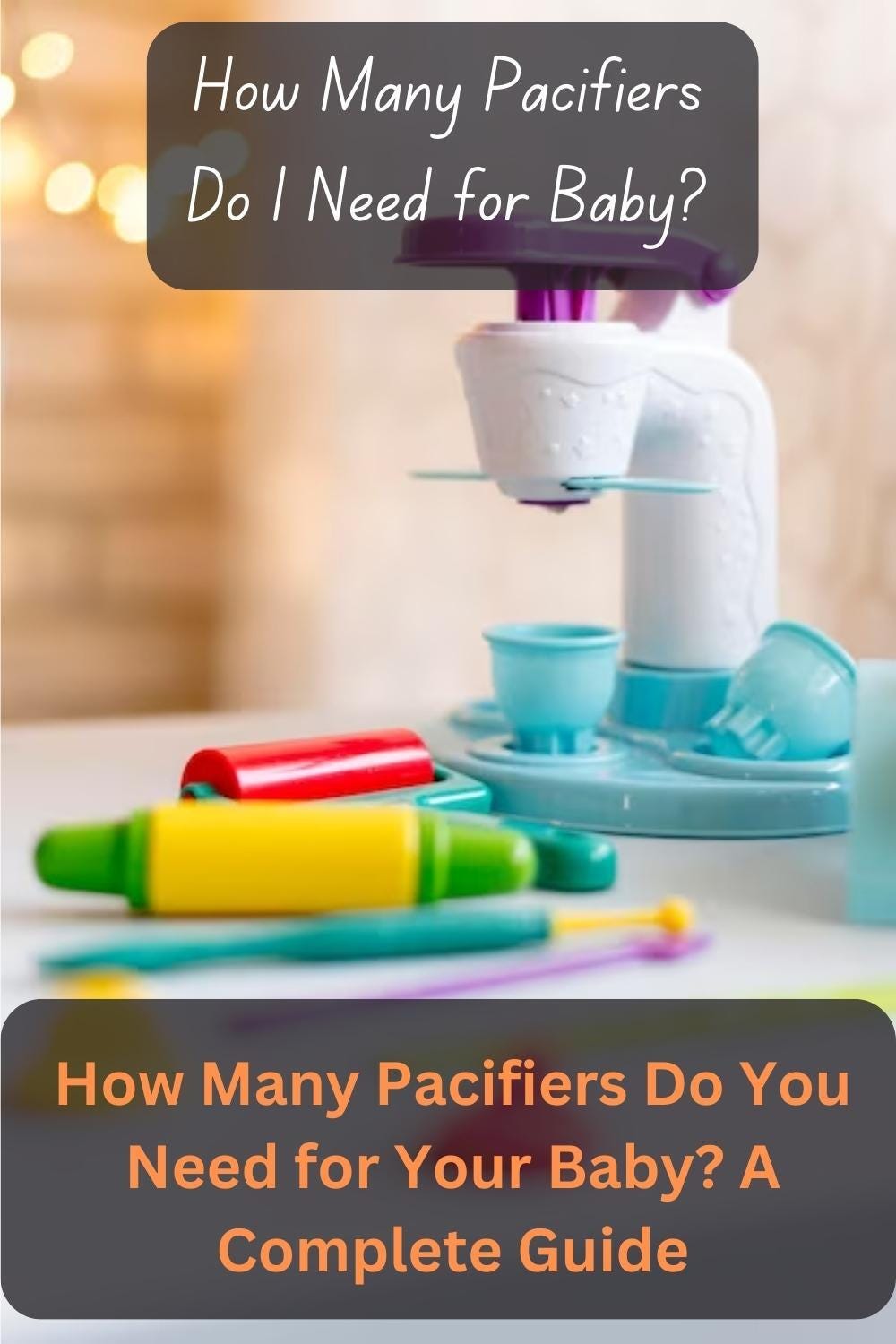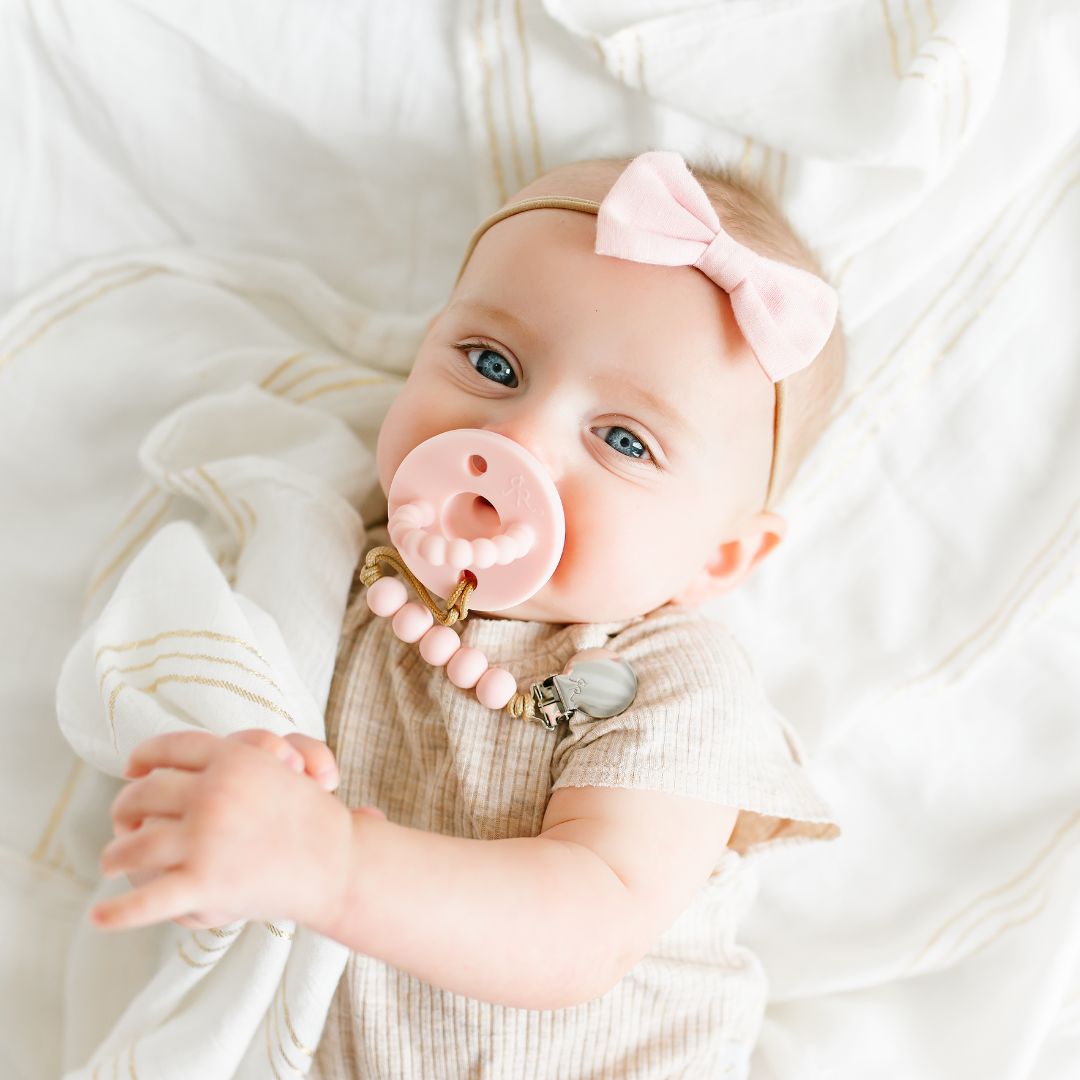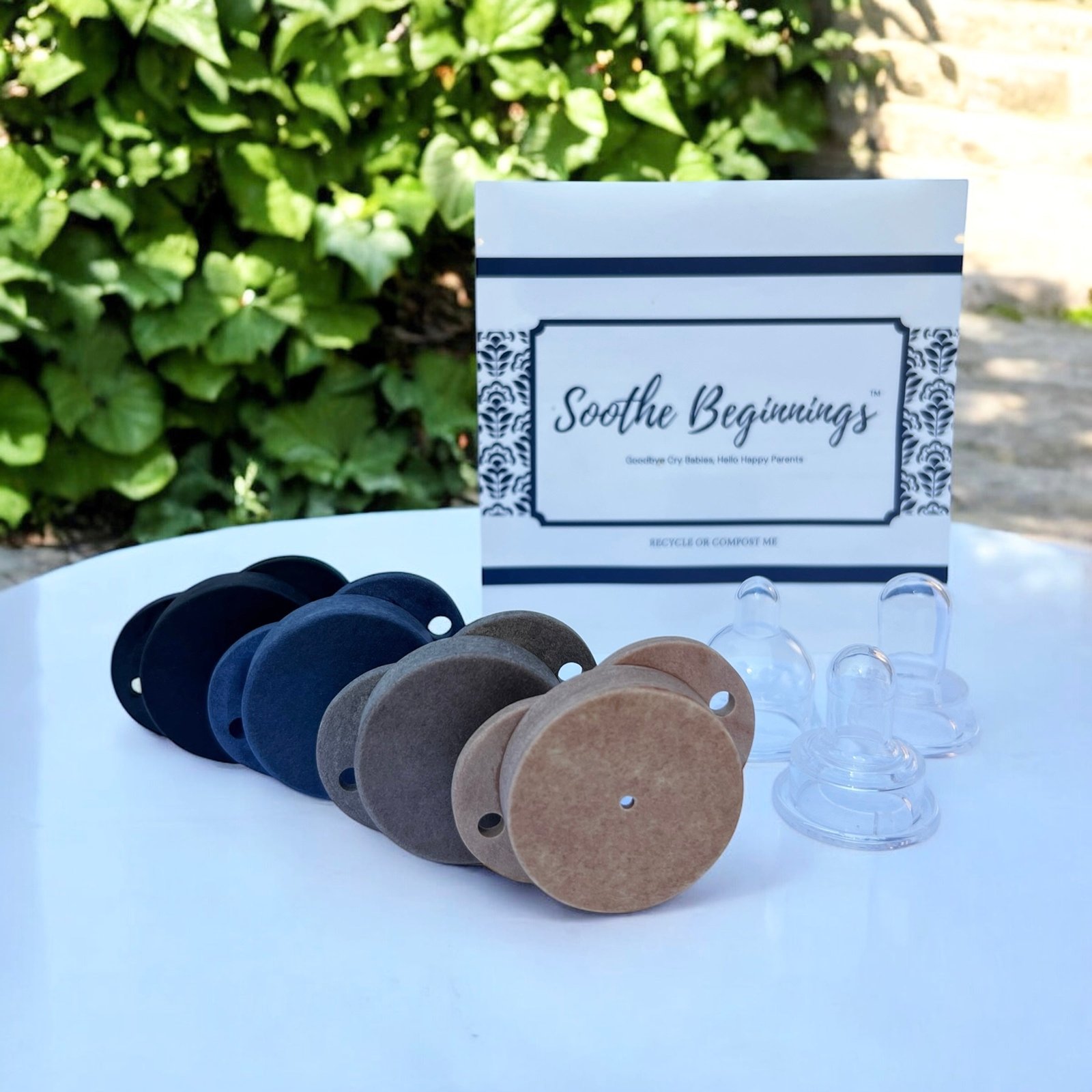You need about two to four pacifiers for your baby. This allows for rotation and ensures you have backups.
As a new parent, you’re likely overwhelmed with baby essentials. Pacifiers are among the many items you’ll juggle. They soothe babies and help parents manage fussy moments. But, how many are truly necessary? It’s easy to overbuy, fearing you might run out during a meltdown.
Understanding the ideal number of pacifiers can simplify your shopping list. It also ensures your baby has enough without cluttering your home. Explore the factors influencing pacifier needs, such as age and habits. This knowledge will help you make informed choices for your little one. Let’s dive into what you should consider when deciding on pacifiers.
Importance Of Pacifiers
Pacifiers are more than just baby accessories. They offer comfort and relief. Many parents swear by their benefits. Understanding the importance of pacifiers can guide your buying decision. They can be a parent’s best friend during challenging times.
Soothing Benefits
Pacifiers provide immediate comfort. Babies often cry for various reasons. Hunger, discomfort, or overstimulation are common causes. A pacifier can calm a distressed baby. The sucking action is natural and soothing. It mimics the comfort of breastfeeding. This calming effect can ease both babies and parents. It offers a simple solution to fussy moments. Having a few pacifiers on hand ensures you’re always prepared.
Impact On Sleep
Pacifiers can significantly improve sleep. Many babies struggle with falling asleep. A pacifier helps in creating a bedtime routine. It signals that it’s time to rest. Babies find comfort and security in sucking. This can lead to longer sleep durations. Parents also benefit from this. More sleep means more energy for daily tasks. Having extra pacifiers ensures a peaceful bedtime. Keep them clean and accessible for nighttime use.

Credit: medium.com
Determining The Right Quantity
When preparing for a new baby, it’s natural to wonder about all the essentials, including pacifiers. You might be asking yourself, “How many pacifiers do I really need?” The answer depends on various factors. Let’s dive into some key considerations to help you determine the right quantity for your little one.
Age Considerations
Babies have different needs at various stages of their development. Newborns might not take to a pacifier immediately. However, by the time they’re a few months old, you may find they use them more frequently. Think about how often your baby might need soothing.
As your baby grows, you may need to replace pacifiers due to wear and tear or changes in their preferences. Infants often drop or lose pacifiers, so having extras can be crucial. Consider starting with a small number and adjust as needed.
Lifestyle Factors
Your lifestyle plays a big role in how many pacifiers you might need. If you’re frequently on the go, having multiple pacifiers stashed in different places can be a lifesaver. Keep one in your diaper bag, another in the car, and some at home.
Think about your baby’s routine. If daycare is part of your schedule, having a dedicated pacifier for there might help. Also, consider backups for travel or visits to friends and family. It’s all about making your life simpler and ensuring your baby stays happy and calm.
Are you someone who prefers minimalism or do you like being extra prepared? Your personality might influence your decision too. Some parents feel secure with just a couple of pacifiers, while others prefer a stash.
Ultimately, ask yourself what fits your lifestyle best. How do you want to handle those inevitable pacifier mishaps?
Types Of Pacifiers
Parents often wonder about the number of pacifiers they need. Various types like orthodontic, silicone, and latex pacifiers offer different benefits. Consider your baby’s preference and daily routine to decide on the quantity. Having a few extras ensures you’re always prepared.
When it comes to choosing the right pacifier for your baby, the variety can be overwhelming. The types of pacifiers available today cater to different needs and preferences, making it essential to understand your options. From the material used to the design, each aspect plays a crucial role in your baby’s comfort and safety.###Material Choices
Pacifiers are typically made from silicone or latex. Silicone pacifiers are more durable and easier to clean, making them a popular choice for many parents. They’re also odorless and tasteless, which some babies prefer.Latex pacifiers, on the other hand, are softer and more flexible. This can feel more natural for some babies, but they do wear out faster. Consider whether your baby shows a preference for one material over the other. It’s also important to note if there’s any allergy risk with latex.###Design Variations
The design of a pacifier can greatly affect how well your baby takes to it. Some pacifiers feature an orthodontic design meant to support healthy oral development. These have a nipple shape that flattens in the mouth, reducing pressure on the gums and developing teeth.Round nipples mimic the natural shape of a bottle nipple, which might be more familiar to bottle-fed babies. Consider if your baby has a preference for a particular shape or if they’re struggling with one type.Some pacifiers come with added features like glow-in-the-dark handles, which make them easier to find at night. Others have vent holes to prevent skin irritation from saliva. Evaluate the features that might be beneficial for your situation.Ultimately, the best pacifier is the one your baby is comfortable with. Have you noticed any particular features your baby seems to prefer? Trying a variety might be the key to finding the perfect fit.
Credit: difrax.com
Safety And Hygiene
Ensuring your baby’s pacifiers are safe and clean is crucial. These tiny tools provide comfort and can soothe your child. But, they also require proper care to maintain hygiene and safety. Regular cleaning and timely replacement are important. This section explains how to keep pacifiers safe and hygienic.
Cleaning Tips
Cleaning pacifiers regularly prevents bacteria build-up. Wash them daily with warm, soapy water. Rinse thoroughly to remove soap residue. Sterilize by boiling them for five minutes. Use a sterilizer for added convenience. Check for any dirt or damage before each use.
Replacement Frequency
Pacifiers should be replaced regularly for safety. Change them every four to six weeks. Inspect for cracks or tears after each wash. Damaged pacifiers pose a choking hazard. Keep extras on hand to ensure you have a clean one available.
Pacifier Storage Solutions
Determining the number of pacifiers needed depends on your baby’s habits. Having at least four pacifiers ensures availability during cleaning or misplacement. This number allows for convenient rotation, keeping them clean and accessible when needed.
Having enough pacifiers is one thing, but storing them efficiently is another. Imagine digging through a diaper bag in the middle of a tantrum—only to find a pacifier wedged under a sippy cup. Not ideal, right? Let’s talk about how you can keep pacifiers organized both at home and on the go.Home Organization
At home, pacifiers seem to disappear at the most inconvenient times. Create a dedicated spot for them. A small, labeled basket on the kitchen counter or a drawer in your baby’s room can do wonders.Consider using a compact organizer with multiple compartments. This way, clean pacifiers remain separate from those that need washing. Some parents even use a simple jar with a lid, which can double as a cute nursery decoration.Are you tired of constantly searching for pacifiers under the couch? Invest in a wall-mounted holder near your child’s crib or play area. It saves time and keeps pacifiers within reach when you need them most.Travel Tips
Traveling with a baby comes with its own set of challenges. Keeping pacifiers clean and accessible is high on that list. Use a small zippered pouch to store pacifiers in your diaper bag.Having a pacifier clip attached to your baby’s outfit can prevent the dreaded drop onto the floor in public spaces.Consider carrying a couple of extra pacifiers in a resealable plastic bag. This keeps them sterile and ready for use. Ever been in an airport restroom trying to wash a pacifier in a tiny sink? Spare yourself the hassle.Do you have a favorite pacifier storage hack that works for you? Share it with other parents in the comments. Your tip might just be the game-changer someone else needs.
Credit: www.ryanandrose.co
Managing Pacifier Usage
Parents often wonder about the ideal number of pacifiers for their baby. Having three to five pacifiers ensures you always have one handy. This helps manage cleanliness and unexpected losses, providing peace of mind.
Managing pacifier usage can be a challenge for many parents. While pacifiers can be a lifesaver in calming a fussy baby, they can also become a crutch that’s hard to let go of. Finding the right balance is key to ensuring your child benefits without becoming overly dependent.Limiting Dependence
It’s easy to let your child have a pacifier whenever they want it, but setting boundaries is crucial. Consider reserving pacifier use for specific times, like naps or bedtime. This helps prevent your child from using it constantly throughout the day.Establishing these boundaries early will make it easier to manage pacifier usage as your child grows. You might find that limiting pacifier use to certain situations reduces the risk of your child becoming overly reliant on it. Have you ever noticed how some children seem to have their pacifier glued to them? Limiting usage can prevent that attachment.Transitioning Off Pacifiers
The transition away from pacifiers can be daunting. However, gradual steps can make the process smoother for both you and your child. Start by reducing the time your child spends with the pacifier each day.As your child becomes more accustomed to less pacifier time, you can introduce the idea of “big kid” activities that don’t involve a pacifier. Encourage them with rewards or praise for going without it. Have you ever tried replacing the pacifier with a favorite toy or activity? This can distract your child from the absence of their pacifier and make the transition easier.Remember, every child is different. What works for one might not work for another, so be patient and flexible in your approach.Common Concerns
Parents often wonder how many pacifiers are necessary for their baby. Having at least three to four pacifiers ensures you have backups during unexpected situations. This number helps maintain hygiene and prevents constant searching for a lost pacifier.
When it comes to pacifiers, parents often have several common concerns. You might wonder about the impact on your child’s dental health or how it could affect their speech development. These are valid questions, and understanding them can help you make informed decisions. Let’s dive into these concerns more deeply.Dental Health
One major worry for parents is whether using a pacifier will harm their child’s dental health. While pacifiers can be a soothing tool, prolonged use might lead to dental issues. Over time, constant sucking can affect the alignment of your child’s teeth and even the shape of their mouth.The key is moderation and timing. Experts suggest limiting pacifier use as your child gets older, especially after their teeth begin to come in. Are you concerned about when to start weaning your child off a pacifier? Consider gradually reducing pacifier time when they reach two years of age. This strategy helps minimize dental risks while still providing comfort in those early months.Speech Development
Another common concern is the impact of pacifiers on speech development. You might worry that constant use could delay your child’s ability to speak. While there is some truth to this, it’s not as straightforward as it seems.Pacifiers can potentially limit the practice time your child has for babbling and experimenting with sounds. However, if you balance pacifier use with ample opportunities for verbal interaction, your child can still thrive. Are you engaging in regular conversations and encouraging your baby to mimic sounds? Doing so can help offset any potential delays.Many parents find success by setting specific times for pacifier use, ensuring it doesn’t interfere with playtime and learning. Ultimately, your involvement and encouragement in your child’s speech development can outweigh any negative impacts of pacifier use.Thinking about these concerns can feel overwhelming, but remember, you’re not alone. Many parents navigate these same challenges, and a balanced approach can often yield the best results for your child’s growth and development.Pacifiers And Emotional Comfort
Parents often wonder about the number of pacifiers needed for their baby. Having several pacifiers ensures your baby always has comfort available, especially during stressful moments. This emotional security helps soothe and calm your little one effectively.
Pacifiers are more than just a tool for soothing babies; they offer emotional comfort that fosters healthy development. As a parent, you might wonder how many pacifiers you need, but understanding their emotional role can guide your decision. Pacifiers can help build security and support your child’s journey toward independence.Building Security
Pacifiers provide a sense of security for babies, acting as a constant, comforting presence. They can be especially useful during unfamiliar or stressful situations like doctor visits or long car rides. My little one always seemed calmer when clutching their pacifier during trips, making the journey less stressful for both of us.Consider how your child reacts to changes in their environment. Does the pacifier help them feel safe? If it does, having a few extras at home and in your diaper bag can ensure you’re never caught off guard.Supporting Independence
While pacifiers offer comfort, they also support independence by allowing babies to self-soothe. This self-soothing is a step towards learning to manage their emotions, an essential skill as they grow.Think about the times your child has calmed themselves with a pacifier. It’s a small but significant step towards independence. Keeping a pacifier within reach can empower them to handle small challenges on their own.You might find it surprising how quickly they learn to retrieve their pacifier when they need it. This simple act can be an early sign of your child’s growing independence.In what ways do you see pacifiers contributing to your child’s emotional growth?Frequently Asked Questions
How Many Pacifiers Do You Really Need?
You typically need 3-5 pacifiers. Having extras is useful for replacements and ensuring cleanliness.
How Often Should You Get New Pacifiers?
Replace pacifiers every 4 to 6 weeks to ensure hygiene and safety. Inspect regularly for damage or wear. Discard immediately if damaged, discolored, or sticky. Proper maintenance keeps your baby safe and comfortable. Always follow manufacturer guidelines for specific recommendations.
How Many Pacifier Holders Do I Need?
You typically need two to three pacifier holders. This ensures you have extras for travel or emergencies. Having a few on hand can help keep pacifiers clean and accessible. Consider your lifestyle and how often you lose items to determine the exact number that suits your needs.
How Many Pacifiers Do You Need To Bring To The Hospital?
Bring one or two pacifiers to the hospital. Babies may not use them immediately, but having options is helpful. Ensure they are clean and safe for newborns. Check with the hospital for any specific guidelines regarding pacifier use. Packing extras can provide peace of mind.
How Many Pacifiers Do Newborns Need?
Newborns typically need about 2-4 pacifiers. This ensures spares for cleanliness and emergencies.
Conclusion
Choosing the right number of pacifiers can make parenting easier. Start with a few to test your baby’s preference. Consider having extras for emergencies or lost pacifiers. Babies often misplace them. A good number is three to five. This allows flexibility and peace of mind.
Remember to check for wear and tear regularly. Replace them as needed for safety. Each baby is unique, so adjust as required. Balance is key. Trust your instincts and adapt to your baby’s needs. Enjoy this special time with your little one.





